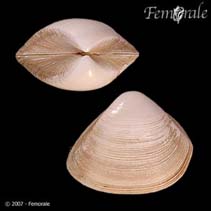Spisula subtruncata (da Costa, 1778)
Subtruncate surf clam
Classification / Names Common names | Synonyms | CoL | ITIS | WoRMS
Bivalvia | Venerida | Mactridae
Environment: milieu / climate zone / depth range / distribution range Ecology
Benthic; brackish; depth range 0 - 25 m (Ref. 2758). Subtropical; 71°N - 30°N, 10°W - 36°E
Distribution Countries | FAO areas | Ecosystems | Occurrences | Introductions
Eastern Atlantic and the Mediterranean.
Length at first maturity / Size / Weight / Age
Maturity: Lm ? range ? - ? cm Max length : 3.0 cm SHL male/unsexed; (Ref. 7882)
Depth based on occurrence (Ref. 2758, p. 805); to be replaced with better reference. Species' maximum length from the Belgian part of the North Sea (Ref. 7882). Found in subtidal environment in coastal areas of Europe (Ref. 80598). Lives in shallow soft bottoms (Ref. 80581); in varied sediment types: from fine to coarse sand and mud (Ref. 7882). An active suspension feeder (Ref. 96376).
Life cycle and mating behavior Maturity | Reproduction | Spawning | Eggs | Fecundity | Larvae
Members of the class Bivalvia are mostly gonochoric, some are protandric hermaphrodites. Life cycle: Embryos develop into free-swimming trocophore larvae, succeeded by the bivalve veliger, resembling a miniature clam.
Main reference
References | Coordinator | Collaborators
Gaspar, M.B., M.N. Santos and P. Vasconcelos. 2001. (Ref. 2758)
IUCN Red List Status (Ref. 130435)
CITES status (Ref. 108899)
Not Evaluated
CMS (Ref. 116361)
Not Evaluated
Threat to humans
Human uses
| FishSource |
Tools
More information
Internet sources
BHL | BOLD Systems | CISTI | DiscoverLife | FAO(Publication : search) | Fishipedia | GenBank (genome, nucleotide) | GloBI | Gomexsi | Google Books | Google Scholar | Google | PubMed | Tree of Life | Wikipedia (Go, Search) | Zoological Record



